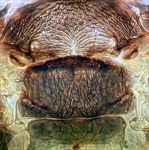Distinguishing features
Female macropterous; body dark brown; all tarsi and bases and apices of tibiae yellow; antennal segment II dark brown, III and IV yellow with apical half light brown, V yellow with apical half brown; fore wing brown, with two white cross bands, at base and sub-apically, apex dark. Head not constricted at base. Antennae 8-segmented, III and IV with forked sensorium, VIII less than twice as long as VII. Pronotum reticulate, many markings within each reticle, no long setae. Metanotum irregularly reticulate, one pair of major setae close to anterior margin. Tarsi elongate but 1-segmented; hind coxae with coiled internal apodeme. Fore wing second vein with five to seven setae; costal cilia shorter than costal setae. Tergite lateral thirds with almost equiangular reticulation and many markings within the reticles; VIII with craspedum medially, tooth-like microtrichia laterally; median split on X about half as long as tergite.
Male tergite IX with three pairs of stout setae medially, median pair thorn-like; sternites III-VII with small transverse pore plate.
Related species
Caliothrips is a genus of 23 species. Most of these are from the New World, with ten in North or Meso-America and three from Carribean Islands. Four species are from Africa and three from Asia, and two species extend into Australia. C. fasciatus is from California and, when taken in quarantine in Australia, can be recognised by the sculpture on the abdominal tergites.
Biological data
Known as the bean thrips in California, and reputed to breed on leaves of various bean plants [Fabaceae]. Although recorded as a pest in California in the 1930's, there have been no recent reports of any damage to crops. Adults sometimes hide inside the navels of oranges, and then cause quarantine problems with fruit imported from California into Australia and New Zealand.
Distribution data
Western USA, between Canada and Mexico; other records are presumed to be misidentifications (Mound et al., 2011). This species is often found in the navels of Citrus exported from California.
Family name
THRIPIDAE, PANCHAETOTHRIPINAE
Species name
Caliothrips fasciatus (Pergande)
Original name and synonyms
Heliothrips fasciatus Pergande, 1895: 391
Caliothrips woodworthi Daniel, 1904: 297.
References
Mound L, Hoddle MS & Hastings A (2019) Thysanoptera Californica. An identification and information system to thrips in California. Lucidcentral.org, Identic Pty Ltd, Queensland, Australia. https://keys.lucidcentral.org/keys/v3/thrips_of_california_2019/
Mound LA, Zhang H-R, Bei Y-W (2011) Caliothrips tongi sp.n. (Thysanoptera, Thripidae) from China, and a dubious record of North American Bean Thrips. Zootaxa 2736: 57–62.
ThripsWiki (2020) Thrips Wiki-providing information on the World’s thrips. Available from: http://thrips.info/wiki/Main Page [accessed 28.viii.2019].
Wilson TH (1975) A monograph of the subfamily Panchaetothripinae (Thysanoptera: Thripidae). Memoirs of the American Entomological Institute 23: 1–354.





